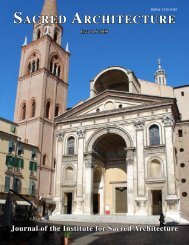Download Issue PDF - The Institute for Sacred Architecture
Download Issue PDF - The Institute for Sacred Architecture
Download Issue PDF - The Institute for Sacred Architecture
- No tags were found...
You also want an ePaper? Increase the reach of your titles
YUMPU automatically turns print PDFs into web optimized ePapers that Google loves.
F E A T U R EPhoto courtesy Duany Plater-Zyberk and Co.Masterplan <strong>for</strong> the Kentlands, Maryland, by Duany Plater-Zyberk and CompanySA: What role do you see the CatholicChurch being able to play in aiding the designor development of new towns?Should it have a role in it at all?EPZ: That is a very interesting question.I think the Catholic Church can playan important role in the revitalization ofneighborhoods. But I am not sure that itneeds to play an initiating role in newplaces, except insofar as the Church may beinterested in building a kind of ideal community.<strong>The</strong>re is a design role that should beplayed by the Church exemplifying thecivic role, the community-focused role thata Catholic Church plays in neighborhoods.And the biggest impediment to this designrole is dimensions. From my own experienceof designing one church in a suburbanpart of Miami and my understanding ofcommon practice, I find that these churchesare very big.<strong>The</strong> big, suburban church that we designedhad to seat 800 in the main sanctuaryand then be able to expand to 1,000 or1,200 <strong>for</strong> special occasions in the Churchyear. Of course, you have to have parking<strong>for</strong> all of those people. <strong>The</strong>n usually thereis a small office component, and a communityroom, and possibly even a school.Consequently, the church campus is verylarge.Even in their smallest permutations,these campuses require an enormous siteand the isolation of buildings amidst parkinglots, like other institutions in suburbia.However, large dimensions can be mitigated.<strong>The</strong>re are alternative solutions. Inthe new traditional neighborhood, the NewUrbanism, the parking is shared with commercialestablishments that are not usedmuch at night or on Sundays. In Canada,public and parochial schools share facilities.<strong>The</strong>y are developed by the governmentand Church, and they share the bigticket items, things like libraries or playingfields, that also happen to take up a lot ofspace.In several Canadian projects, we foundthere was a feasible way to put schools togetherin the greenbelt between the severalneighborhoods from which they draw theirstudents, who can walk to school. <strong>The</strong> institutionon the edge, rather than at thecenter of the neighborhood, is the least disruptiveof its walkability.In the New Urbanism, that is, in a compact,pedestrian-oriented community, dimensionsand measures are extremely important.<strong>The</strong> way we build churches nowsometimes seems contradictory to the goalof making these places pedestrian-friendlyand acceptable.In older neighborhoods where thereusually are already churches, the initiativesmay have less to do with the buildingitself reacting to its role in the physical fabricand more with revitalization. Renovationshould not be accomplished in such away that the building becomes defensiveagainst hostile surroundings, or that it beginsto take apart the neighborhood bysuburbanizing the urban fabric around it.I have often thought that wealthy, suburbancongregations could adopt congregationsin the inner city and do some concreteprojects, like building and rebuildinghousing <strong>for</strong> people in those places. I amsure that this already goes on in variousparts of the country. But all involved haveto pay attention to the fact that the structureof the physical environment is important.Not only <strong>for</strong> increasing the economicvalue of the place over time, but to promotegood community.SA: From your experience with churchprojects, what are some of the issues in designinga new church building, whether itbe in an established neighborhood or in anewly planned development?EPZ: We designed a little church in aneighborhood in Miami. It was initiated bya pastor who thought that if he franchisedsmaller chapels, creating what he called“missions” within his large parish then hemight be able to influence behavior inthose areas which weren’t within walkingdistance of the big church.So, we designed one on a 50 x 100 foot<strong>Sacred</strong><strong>Architecture</strong> Fall 2000 9










